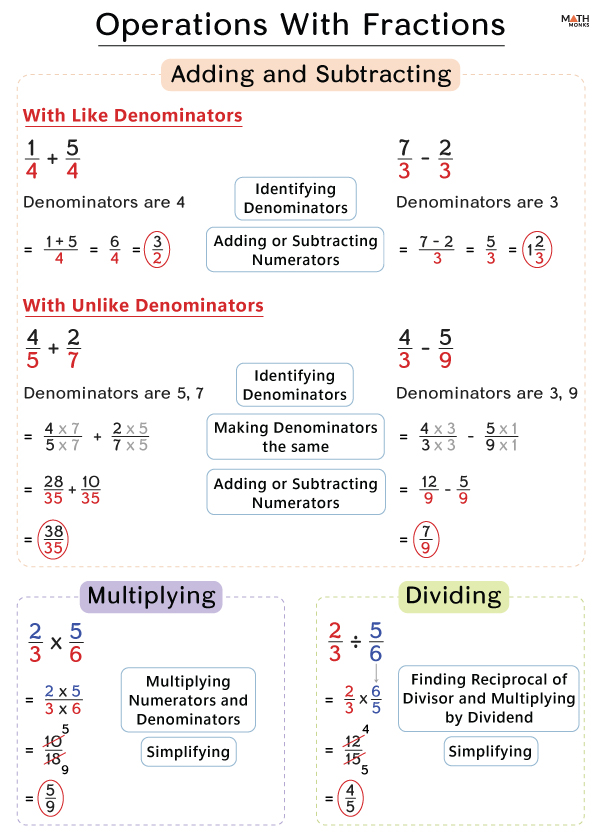Similar to operations with whole numbers, the four basic operations – addition, subtraction, multiplication, and division, are also performed on fractions to simplify problems involving them.
Adding and Subtracting
To add or subtract fractions, they must have the same denominator. If not, we need to find their common denominator.
With Like Denominators
When adding or subtracting the fractions with the same denominator, we simply add or subtract the numerators.
Let us add ${\dfrac{1}{4}}$ and ${\dfrac{5}{4}}$
Identifying the Denominators
Here, the denominators are 4 and 4
Adding the Numerators
Now, ${\dfrac{1}{4}+\dfrac{5}{4}}$
On adding the numerators,
= ${\dfrac{1+5}{4}}$
= ${\dfrac{6}{4}}$
Simplifying
${\dfrac{3}{2}}$
Similarly, now let us subtract: ${\dfrac{7}{3}-\dfrac{2}{3}}$
Given, ${\dfrac{7}{3}-\dfrac{2}{3}}$
Identifying the Denominators
Here, the denominators are 3 and 3
Now, ${\dfrac{7}{3}-\dfrac{2}{3}}$
Subtracting the Numerators
= ${\dfrac{7-2}{3}}$
= ${\dfrac{5}{3}}$, which is in its simplest form.
Thus, the difference is ${\dfrac{5}{3}}$
With Unlike Denominators
When adding or subtracting the fractions with different denominators, we find the common denominator first and then add or subtract the numerators.
Let us subtract ${\dfrac{5}{9}}$ from ${\dfrac{4}{3}}$
${\dfrac{4}{3}-\dfrac{5}{9}}$
Identifying the Denominators
Here, the denominators are 9 and 3, which are different.
Finding the LCM of the Denominators
The LCM of 9 and 3 is 9
Making the Denominators the Same
Converting ${\dfrac{4}{3}}$ to its equivalent fraction with 9 as the denominator,
${\dfrac{4}{3}}$ = ${\dfrac{4\times 3}{3\times 3}}$ = ${\dfrac{12}{9}}$
Now, we have ${\dfrac{12}{9}-\dfrac{5}{9}}$
Subtracting the Numerators
On subtracting the numerators,
= ${\dfrac{12-5}{9}}$
= ${\dfrac{7}{9}}$
Now, let us add: ${\dfrac{4}{5}+\dfrac{2}{7}}$
Given, ${\dfrac{4}{5}+\dfrac{2}{7}}$
Identifying the Denominators
Here, the denominators are 5 and 7, which are different.
Finding the LCM of the Denominators
The LCM of 5 and 7 is 35
Making the Denominators the Same
Now, converting ${\dfrac{4}{5}}$ and ${\dfrac{2}{7}}$ to their equivalent fractions with 35 as the denominator,
${\dfrac{4}{5}}$ = ${\dfrac{4\times 7}{5\times 7}}$ = ${\dfrac{28}{35}}$
${\dfrac{2}{7}}$ = ${\dfrac{2\times 5}{7\times 5}}$ = ${\dfrac{10}{35}}$
Now, we have ${\dfrac{4}{5}+\dfrac{2}{7}}$
Adding the Numerators
= ${\dfrac{28}{35}+\dfrac{10}{35}}$
= ${\dfrac{28+10}{35}}$
= ${\dfrac{38}{35}}$, which is in its simplest form.
Thus, the sum is ${\dfrac{38}{35}}$
Multiplying and Dividing
To multiply fractions, we multiply the numerators and the denominators separately to get the product.
Let us multiply ${\dfrac{2}{3}\times \dfrac{5}{6}}$
Multiplying the Numerators and Denominators Separately
= ${\dfrac{2\times 5}{3\times 6}}$
= ${\dfrac{10}{18}}$
Simplifying
= ${\dfrac{5}{9}}$
Thus, the product is ${\dfrac{5}{9}}$
Problem – Multiplying by an INTEGER
![]() Multiply ${\dfrac{7}{6}\times 10}$
Multiply ${\dfrac{7}{6}\times 10}$
Solution:
![]()
Given, ${\dfrac{7}{6}\times 10}$
Multiplying the Numerators and Denominators Separately
= ${\dfrac{7\times 10}{6}}$
= ${\dfrac{70}{6}}$
Simplifying,
= ${\dfrac{35}{3}}$
Thus, the product is ${\dfrac{35}{3}}$
To divide fractions, we multiply the first fraction by the reciprocal of the second fraction.
Let us divide ${\dfrac{2}{3}}$ by ${\dfrac{5}{6}}$
Finding the Reciprocal of the Second Fraction
Here, the reciprocal of ${\dfrac{5}{6}}$ is ${\dfrac{6}{5}}$
Now, ${\dfrac{2}{3}\div \dfrac{5}{6}}$
Multiplying it by the First Fraction
= ${\dfrac{2}{3}\times \dfrac{6}{5}}$
= ${\dfrac{2\times 6}{3\times 5}}$
= ${\dfrac{12}{15}}$
Simplifying
= ${\dfrac{4}{5}}$
Thus, the quotient is ${\dfrac{4}{5}}$
![]() Divide ${\dfrac{14}{15}\div \dfrac{12}{18}}$
Divide ${\dfrac{14}{15}\div \dfrac{12}{18}}$
Solution:
![]()
Given, ${\dfrac{14}{15}\div \dfrac{12}{18}}$
Finding the Reciprocal of the Second Fraction
Here, the reciprocal of ${\dfrac{12}{18}}$ is ${\dfrac{18}{12}}$
Multiplying it by the First Fraction
= ${\dfrac{14}{15}\times \dfrac{18}{12}}$
= ${\dfrac{14\times 18}{15\times 12}}$
= ${\dfrac{252}{180}}$
Simplifying,
= ${\dfrac{7}{5}}$
Thus, the quotient is ${\dfrac{7}{5}}$
Here is a summary of what we have learned so far.

